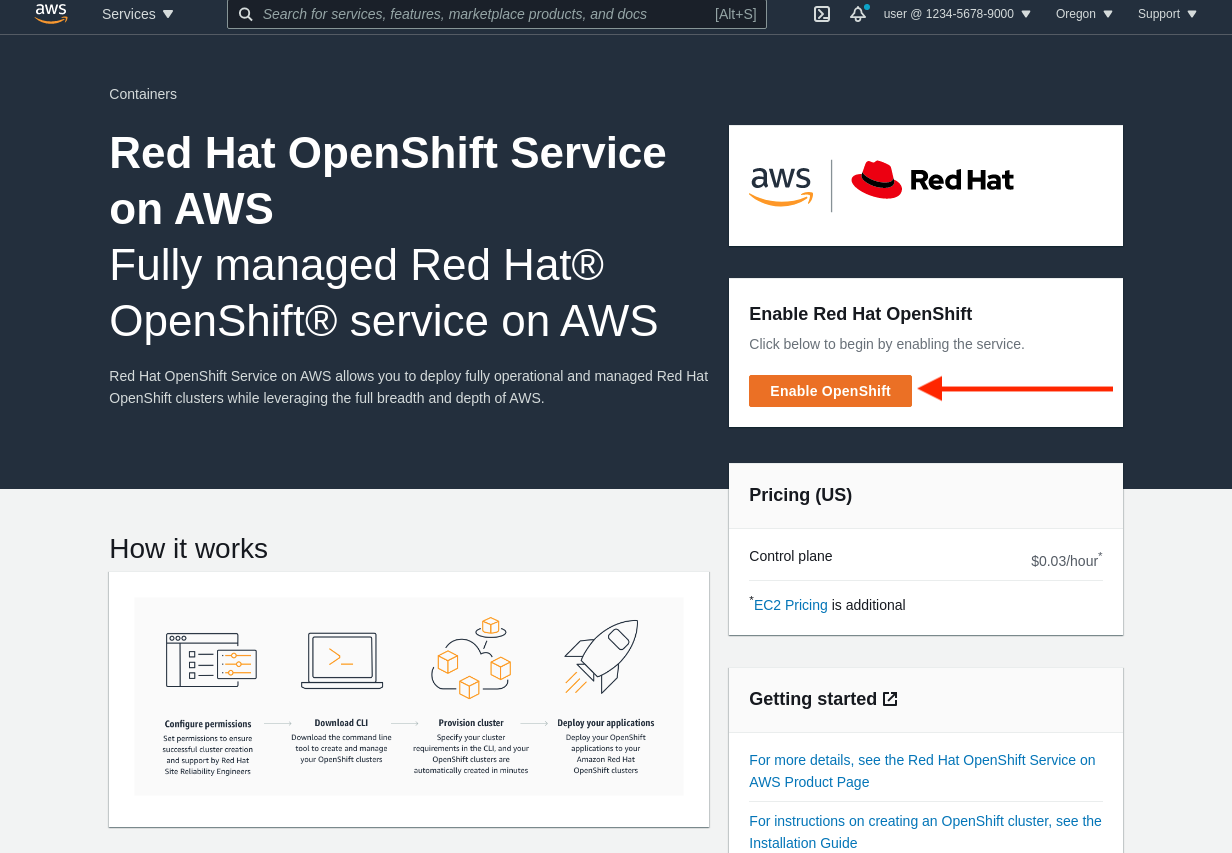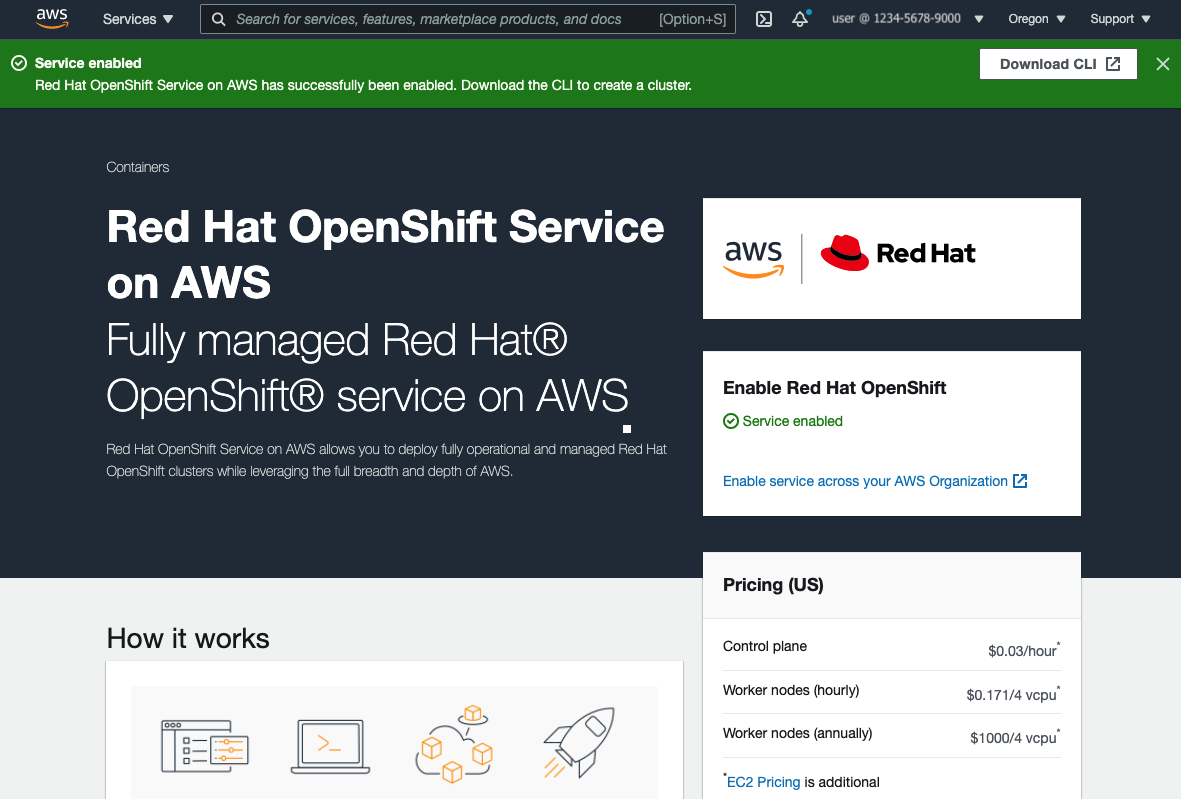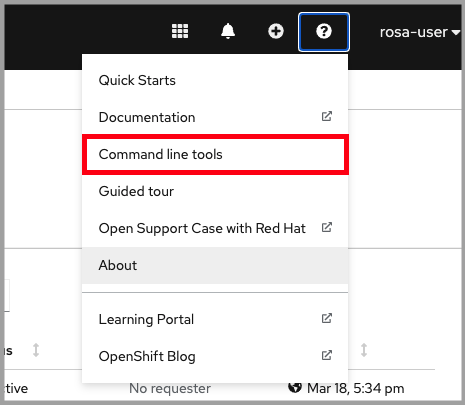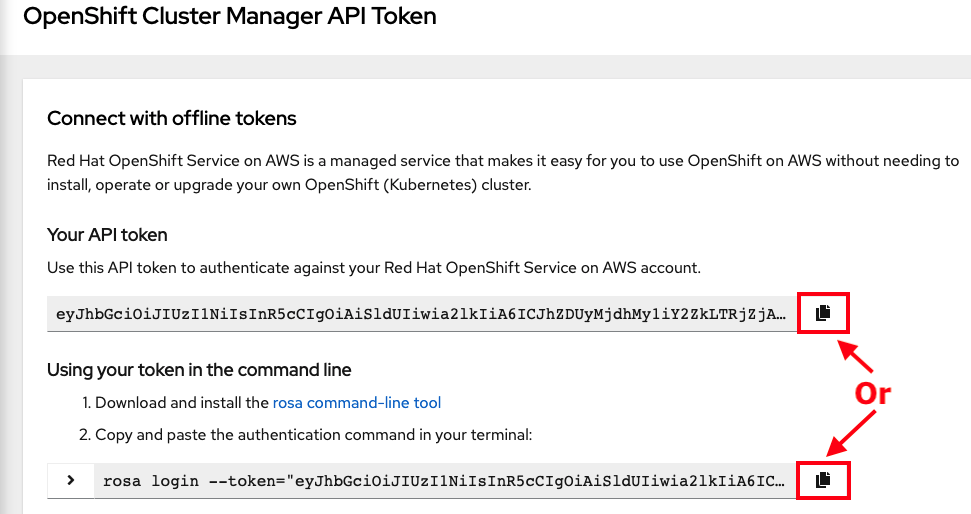Setup
There are currently two supported credential methods when creating a ROSA cluster. One method uses an IAM user with the AdministratorAccess policy (only for the account using ROSA). The other, more recent, and recommended method uses AWS STS. Please see the section "ROSA with STS Explained" for a detailed explanation. In this workshop we will only be using the STS method.
Prerequisites#
Please review the prerequisites found in the documentation at Prerequisites for ROSA w/STS before getting started.
You will need the following pieces of information from your AWS account:
- AWS IAM User
- AWS Access Key ID
- AWS Secret Access Key
A Red Hat account#
If you do not have a Red Hat account, create one here https://console.redhat.com/. Accept the required terms and conditions. Then check your email for a verification link.
Install the AWS CLI#
Install the AWS CLI as per your operating system.
Enable ROSA#
Complete this step if you have not enabled ROSA in your AWS account.
- Visit https://console.aws.amazon.com/rosa to enable your account to use ROSA.
-
Click on the orange "Enable OpenShift" button on the right.

-
It will take about a minute and then you will see a green "service enabled" bar at the top.

Install the ROSA CLI#
- Install the ROSA CLI as per your operating system.
- Download and extract the relevant file for your operating system
- ex:
tar -xvf rosa-linux.tar.gz
- ex:
- Save it to a location within your "PATH".
- ex:
sudo mv rosa /usr/local/bin/rosa
- ex:
- Run
rosa versionto make sure it works and that it returns the version number.
Install the OpenShift CLI#
There are a few ways to install the oc CLI:
- If you have the
rosaCLI installed, the simplest way is to runrosa download oc- Once downloaded, untar (or unzip) the file and move the executables into a directory in your PATH
- Or, you can download and install the latest OpenShift CLI (oc)
- Or, if you already have an OpenShift cluster you can access the command line tools page by clicking on the Question mark > Command Line Tools. Then download the relevant one for your operating system.

Why use oc over kubectl
Being Kubernetes, one can definitely use kubectl with their OpenShift cluster. oc is specific to OpenShift in that it includes the standard set of features from kubectl plus additional support for OpenShift functionality. See Usage of oc and kubectl commands for more details.
Configure the AWS CLI#
If you've just installed the AWS CLI, or simply want to make sure it is using the correct AWS account, follow these steps in a terminal:
- Enter
aws configurein the terminal - Enter the AWS Access Key ID and press enter
- Enter the AWS Secret Access Key and press enter
- Enter the default region you want to deploy into
-
Enter the output format you want (“table” or “json”). For this guide you can choose “table” as it is easier to read but either is fine.
It should look like the following as an example:
$ aws configure AWS Access Key ID: AKIA0000000000000000 AWS Secret Access Key: NGvmP0000000000000000000000000 Default region name: us-east-1 Default output format: table
Verify the configuration#
Verify that the configuration is correct.
-
Run the following command to query the AWS API
aws sts get-caller-identity -
You should see a table (or JSON if that’s what you set it to above) like the below. Verify that the account information is correct.
$ aws sts get-caller-identity ------------------------------------------------------------------------------ | GetCallerIdentity | +--------------+----------------------------------------+--------------------+ | Account | Arn | UserId | +--------------+----------------------------------------+--------------------+ | 000000000000| arn:aws:iam::00000000000:user/myuser | AIDA00000000000000| +--------------+----------------------------------------+--------------------+
Ensure the ELB service role exists#
Make sure that the service role for ELB already exists, otherwise the cluster deployment could fail. As such, run the following to check for the role and create it if it is missing.
aws iam get-role --role-name "AWSServiceRoleForElasticLoadBalancing" || aws iam create-service-linked-role --aws-service-name "elasticloadbalancing.amazonaws.com"
If you received an error during cluster creation like below, then the above should correct it.
Error: Error creating network Load Balancer: AccessDenied: User: arn:aws:sts::970xxxxxxxxx:assumed-role/ManagedOpenShift-Installer-Role/163xxxxxxxxxxxxxxxx is not authorized to perform: iam:CreateServiceLinkedRole on resource: arn:aws:iam::970xxxxxxxxx:role/aws-service-role/elasticloadbalancing.amazonaws.com/AWSServiceRoleForElasticLoadBalancing"
Log into your Red Hat account#
- Enter
rosa loginin a terminal. -
It will prompt you to open a web browser and go to:
-
If you are asked to log in, then please do.
- Click on the "Load token" button.
-
Copy the token and paste it back into the CLI prompt and press enter. Alternatively, you can just copy the full
rosa login --token=abc...command and paste that in the terminal.
Verify credentials#
Verify that all the credentials set up are correctly.
-
Run
rosa whoamiYou should see an output like below:
AWS Account ID: 000000000000 AWS Default Region: us-east-2 AWS ARN: arn:aws:iam::000000000000:user/myuser OCM API: https://api.openshift.com OCM Account ID: 1DzGIdIhqEWy000000000000000 OCM Account Name: Your Name OCM Account Username: you@domain.com OCM Account Email: you@domain.com OCM Organization ID: 1HopHfA20000000000000000000 OCM Organization Name: Red Hat OCM Organization External ID: 0000000 -
Please check all information for accuracy before proceeding.
Verify quota#
Verify that your AWS account has ample quota in the region you will be deploying your cluster to. Run the following:
rosa verify quota
Should return a response like
I: Validating AWS quota...
I: AWS quota ok. If cluster installation fails, validate actual AWS resource usage against https://docs.openshift.com/rosa/rosa_getting_started/rosa-required-aws-service-quotas.html
See the documentation for more details regarding quotas.
Verify oc CLI#
Verify that the oc CLI is installed correctly
rosa verify openshift-client
We have now successfully set up our account and environment and are ready to deploy our cluster.
Cluster Deployment#
In the next section you will deploy your cluster. There are two mechanisms to do so:
- Using the ROSA CLI
- Using the OCM Web User Interface
Either way is perfectly fine for the purposes of this workshop. Though keep in mind that if you are using the OCM UI, there will be a few extra steps to set it up in order to deploy into your AWS account for the first time. This will not need to be repeated for subsequent deployments using the OCM UI for the same AWS account.
Please select the desired mechanism in the left menu under "Deploy the cluster".